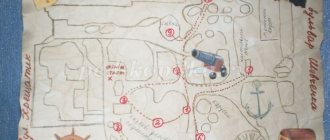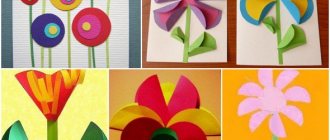Progress of the game.
Lay out 8-10 pictures on the table. Ask your child to name them (so that you are sure that the child knows what these words are called). Ask
child remember them. Then, on the command “close your eyes,” the child closes his eyes. Remove one of the pictures, then ask the child to open his eye and guess which picture is missing.
Target:
learn to distinguish colors, focusing on their uniformity or heterogeneity when applied; denote the result with the words “such”, “not such”; act by imitation.
Equipment:
ten large flowers made of cardboard with a variety of colors, ten flat figures of butterflies of the same color as the flowers according to the number of children.
We bring to your attention educational games - series: “Insects” for children from 4 to 5 years old.
Didactic games “Insects” for children
From 4 to 5 years
We bring to your attention educational games - series: “Insects” for children from 4 to 5 years old.
From ordinary stickers that children like, you can create a series of educational games.
Place and stick the required material on regular colored cardboard and you will get cards for completing tasks. You can make vases from plastic bottles. Paste colorful, interesting, voluminous stickers with images of insects on them. In each vase, put colored woolen threads, additional illustrative material, and plastic stoppers with small stickers depicting insects.
When working with one card, you can come up with several game options. Invite your child to fantasize, come up with something of his own, different options for consolidating the material covered, or just play. Surprise your child, get him interested, read a comic, interesting, funny poem, ask a riddle about summer, about insects, and let the child guess what, where it is, how and what we will play with.
Game No. 1. “Help the butterflies find their flower.”
Tasks:
Expand children's knowledge about butterflies. Enrich children's knowledge on this topic. Name and distinguish between meadow and garden flowers. To form stable ideas about color, quantity, orientation in space, exercises in counting.
Tasks:
“Which butterfly is the most beautiful?”, “What is your favorite color?”, “Why do flowers smile?”, “What do you want to change?”, “What do you think of?”, “Let’s come up with a fairy tale, what comes first, what comes next? " Count how many flowers there are. Name the flowers. Count how many butterflies are blue, pink, yellow, lilac.
Game No. 2. "Fun in the Meadow"
Tasks:
Develop thinking, speech, ability to generalize, answer questions. Help children form plural forms of verbs.
Tasks:
“What geometric shapes do butterflies hide in?”, “Where do mosquitoes fly?”, “What do mosquitoes do?” (fly, ring, bite., “Where do the mosquitoes sleep?”, “Which direction did the bees fly?”, “What are the bees doing?” (fly, collect pollen, find flowers, buzz, sting). Help the bees find a flower. Count insects. Count the flowers. What's extra?
You can ask leading questions: “Who is higher?”, “Who is lower?”, “Who is below?”. Denote in words the position of one object relative to another. When counting, you can cover any depicted object with a geometric figure cut out of cardboard and ask the question: “Count how many?”, “Where, who hid?”, “Who flew where?”, “What do you think?”, “Come up with your own story?".
Game No. 3. “Confusion - confusion.”
Goals:
- Form spatial directions (right, left, top, bottom, upper right - lower corner, upper left - lower corner, middle);
- Ability to navigate on a sheet of paper (straight, winding, zigzag lines).
Tasks:
“Help the cheerful butterflies and resourceful caterpillars”, “Lay out a path with a thread.”
For this game you can use woolen knitting threads. They attract with the magnificence of the colors, are convenient for completing the task, and are easy to place on a sheet of paper. When performing such activities, children develop fine motor skills of their fingers and hands and motor coordination.
It is very important to teach a child to think correctly, to think logically, consistently, and to draw certain conclusions.
Progress of the game.
The teacher explains that the bees want to find their flowers - to sit on a flower so that they cannot be seen, and no one will
was able to catch them. We need to help the bees hide. The teacher examines the bees, drawing the children’s attention to the fact that the color of the bee and the flower are the same (“the same”), the bee is not visible - it is hidden. Then the children take bees and flowers out of the envelopes and complete the task.
Target:
correctly arrange objects as they increase (or decrease).
Material:
a plot picture depicting 10 butterflies of different sizes and 10 carriages corresponding to the size of the butterflies, colored pencils.
Progress of the game.
Invite your child to listen to a short story: “Spring has come. The cabbage butterfly has beautiful daughters. They were very beautiful and elegant in yellow dresses. The butterfly decided to go with them to the spring ball. And since the butterfly daughters were of different heights, the carriages were also different.”
Invite your child to show butterflies and carriages according to their size. Ask to plant beautiful butterflies in them (in accordance with
the size of the carriage) - draw a line with a colored pencil from the butterfly to the corresponding carriage. Invite your child to name the size of the carriages in descending (ascending) order. Then offer to name the size of the beautiful butterflies (ascending) or descending.
Complication: play the game orally. Invite your child to arrange the butterflies by height, using the adjectives “small” in the game.
“tiny”, “tiny”, “very small”. You can arrange the butterflies in ascending or descending order.
One beetle - many beetles. One mosquito - many mosquitoes. One fly - many flies.
One butterfly - many butterflies. One dragonfly - many dragonflies. One ant - many ants. One midge - many midges.
One bee - many bees. One bumblebee - many bumblebees.
Target:
expansion of visual attention, perception and memory; development of fine motor skills.
Material:
picture with a superimposed image of a pear, leaf and butterfly.
WITH INTERNATIONAL PARTICIPATION IN AWARENESS WITH THE AROUND WORLD
ALL-RUSSIAN QUIZ
REGULATIONS ON THE QUIZ
on the website of the Internet portal “Children are the flowers of life”, a certificate of media registration in Roskomnadzor: EL No. FS77-64892 Timing of the quiz: CONSTANTLY Quiz results FOR THE NEXT DAY Quiz results are periodically updated
To teach children to properly relate to the natural world, it is necessary to give them certain knowledge about living and inanimate nature.
The purpose of the quiz is to help expand and generalize children’s ideas about insects (appearance, habits, benefits, human attitude towards insects); develop logical thinking, reasoning skills, attention, memory of children; to develop in children an interest in insects, experimental activities and a caring attitude towards them.
We invite you to take part in the quiz. If your child successfully completes the tasks, this is very good. If he encounters difficulties while completing tasks, carefully analyze the problems of such failure and “pull up” the child on this topic.
Participants of the competition: Preschoolers (children 4 - 7 years old), primary classes.
How to participate:
1. tasks and print out the quiz – Quiz. 2. Read the assignments to your child, carefully look at the pictures with him, explain to him what needs to be done. 3. Offer to find the correct answer yourself. Count the points. If your participant is 4 years old, then help him complete tasks in accordance with the program for this age.
4. Fill out the application to participate in the competition. Application for competitions and quizzes. 5. Pay the registration fee - 50 rubles for registration of one Diploma. If there are several participants, then you can pay one amount for all participants. In the application, list who is paying for it. The application contains one participant and one curator. For a second curator, pay an additional 50 rubles. You can pay with one check. The second curator receives a separate Diploma in his last name. 6. Pay the registration fee of 50 rubles for the Curator Certificate (if needed) and fill out an application for a curator. Without payment for the registration of the Diploma for the quiz participant, the Certificate will not be issued to the curator.
Application for a supervisor certificate.
A free Curator Certificate is issued for 5 or more participants in one quiz. 7. Send an email to [email protected] In the Subject line of the email, indicate the name of the quiz.
How to submit your work: 1. Attach your application to a letter in Word format. In case of an error made when filling out the application, corrections in diplomas will be made for an additional fee (50 rubles). We correct our mistakes free of charge. All works are sent to your E-mail specified in the application. 2. Receipt (scan or jpg). The main thing is that all numbers and all information are clear and easy to read. If you paid on the page of our website, then indicate the exact time, date, amount and only your last name from your bank card. Read more about the procedure and methods of payment on the “payment” page. 3. Attach separate files to one letter: - application in Word format; - check; - competitive work. Applications and competition entries that do not meet the requirements of this provision will not be accepted or considered. If after 2 days you do not receive the Diploma, send the letter again and write in the SUBJECT of the letter: “name of the quiz” - again. After summing up the results, Diplomas are sent out free of charge. Curators will receive a Curator Certificate.
If you notice a typo or discrepancy in the application in the Diploma, send a repeat of the application and correctly indicate what to change.
On this page, the registration fee must be paid on the day the application is submitted.
Note: Please pay attention to the correctness of the data you provided when paying through our “Pay” button, namely: last name, first name and MUST email address. The email address specified must match the email address from which you plan to send the material. Confirm payment with a photo of the receipt. Please indicate for whom the payment was made. If you paid via mobile phone, then indicate the amount, time and telecom operator.
Progress of the exercise.
Each child has a coloring book “Insects”, a set of colored pencils and a stencil on the table. The teacher invites the children to choose the insect they like and shade it using any shading method (vertical, horizontal, wavy, diagonal, cross, circular, broken).
"Fly"
On a large square of 10/10 cells, a fly is drawn in the middle.
The teacher talks about where the insect is moving, and everyone must follow the cells. Then the question is asked: “Where is the fly?”
Target:
identify the causes of the origin of low and high sounds (sound frequency).
Material:
plastic combs with different frequencies and tooth sizes.
Edible-inedible
The purpose of the didactic game is to teach preschoolers to distinguish between edible and inedible mushrooms. This activity requires pictures of mushrooms and a basket.
The teacher asks a riddle about a mushroom. Children guess and find the image among the pictures. If the mushroom is edible, put the picture in the basket.
Teaching ecology in a playful way arouses interest in children, develops curiosity, thinking ability and desire to understand the world around them, and broadens their horizons. Preschoolers consolidate knowledge about the world around them and gain an understanding of the relationships between natural objects and phenomena.
Progress of experience.
The teacher asks the children to run a plastic plate over the teeth of different combs, determine whether the sound is the same and what the frequency of the sound depends on. Children pay attention to the frequency of teeth and the size of combs. They find out that combs with large, sparse teeth have a low, rough, loud sound; combs with frequent fine teeth have a thin, high-pitched sound.
Children look at illustrations of a mosquito and
bumblebee, determine their size. Then they imitate the sounds they make: the mosquito’s sound is thin, high-pitched, it sounds like “z-z-z”; in the bumblebee it is low, rough, sounds like “zh-zh-zh”. children say that a mosquito flaps its small wings very quickly, often, so the sound is high;
The bumblebee flaps its wings slowly and flies heavily, so the sound is low.
Target:
develop optical-spatial perception, imagination, observation.
Equipment:
pictures on small cardboard (half a landscape sheet), glue, glue brush,
bags of sand of different colors.
Progress of the game.
First we spread glue on all the places in the picture that will be, for example, yellow, pour the contents of one sachet onto the picture, let it dry, pour the excess from the picture back into the container. Like paints, colored
sand can be mixed together in different proportions to obtain the desired shade.
Target:
development of integrity of perception; learn to distinguish between left and right; build a symmetrical pattern.
Material:
a sheet of checkered paper with a drawn pattern.
Progress of the exercise.
Children are encouraged to consider
what is drawn. Then it is proposed to mirror the second half of the picture
Target:
develop fine motor skills and spatial orientation.
Materials:
egg cartons, scissors, paints, toothpicks, flexible cocktail straws, doll eyes.
Progress.
From the packaging, cut one section with two cells and two - one at a time. Color the blanks green, red and brown. Paint the toothpicks black, break them off and insert them into
ladybug body and caterpillars. Draw dots on top of the ladybug with black paint. Take some cocktail straws and cut them so that you have bending arms. Using the tip of the scissors, make holes in the body of the spider and insert the legs - tubes. Glue on the doll's eyes.
Target:
develop imagination, spatial thinking and imagination, concentration and fine motor skills.
Equipment:
square sheets of paper of different colors.


